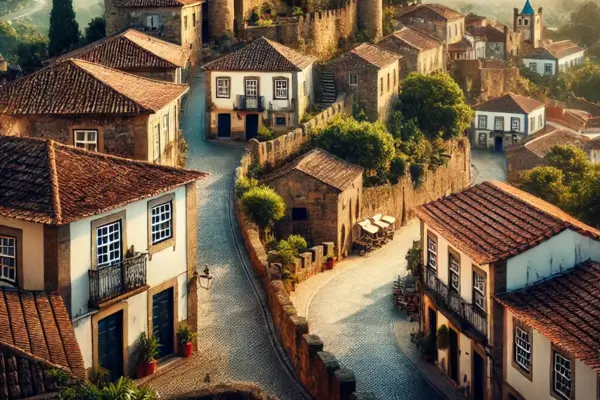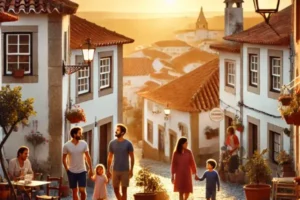Portugal’s history is as rich and diverse as its landscapes, offering a fascinating journey from the Age of Exploration to the modern-day. For expatriates moving to Portugal with their families, exploring the country’s historical sites is a meaningful way to connect with its culture and heritage. It’s not just about sightseeing—it’s about learning, growing, and bonding as a family in a place that’s welcoming and full of stories waiting to be discovered.
As you settle into life in Portugal, visiting historical landmarks can help your family integrate more deeply into the local community. It’s a chance to teach your kids about the country’s past while also creating lasting memories in a new environment. This guide will show you how to make the most of Portugal’s rich history, from interactive experiences to practical tips for families on a budget.
In the following sections, you’ll find family-friendly historical sites, activities that keep kids engaged, and practical advice for navigating Portugal with your little ones. Whether you’re seeking affordable housing or looking to enrich your family’s Portuguese experience, this guide will help you explore the best of both worlds.
Why Portugal’s History is So Interesting for Families
Portugal’s past is as colorful as it is varied, from its role as a maritime powerhouse during the Age of Exploration to its fascinating blend of Roman, Moorish, and Christian influences. For families, this means a wide range of historical sites to visit and explore, from grand castles to ancient ruins. Whether you’re strolling through the medieval streets of Porto or visiting the majestic Belem Tower in Lisbon, each corner of the country tells a different story—perfect for sparking a child’s imagination.
Educational, Fun, and Immersive Learning for Kids
One of the biggest advantages of immersing your kids in Portugal’s history is the learning opportunity it provides. Unlike classroom lessons, visiting historical sites turns history into a living, breathing subject. Kids can walk through the halls of palaces, climb the walls of castles, and even see ancient artifacts firsthand. This kind of hands-on learning helps children understand the context behind what they read in textbooks and makes it all feel real. It also provides an opportunity for you to teach them about Portugal’s unique culture in an engaging way.
A Family-Friendly Culture that Embraces Kids
Portuguese culture is notably family-oriented, and this extends to the way children are welcomed at historical sites. Many museums, castles, and even guided tours are designed with families in mind, offering interactive exhibits or activities specifically for children. In Portugal, kids are often seen as an integral part of the cultural experience, with locals eager to make sure they feel included. The welcoming attitude of the Portuguese towards children can make visiting historical landmarks less stressful for parents and more enjoyable for kids.
Whether you’re looking to engage your children in Portugal’s past or just want to make a day out of it, the country’s history provides a perfect blend of fun and education, wrapped in a culture that feels like home.
Key Historical Sites to Visit with Your Kids in Portugal
Portugal is home to a treasure trove of historical landmarks, many of which are perfect for families looking to blend education and fun. From royal palaces to ancient castles, these sites offer an immersive journey through time that will captivate both adults and children. Here’s a curated list of must-see historical spots that are especially family-friendly:
Belem Tower, Lisbon: A Dive into Portugal’s Maritime History
Belem Tower (Torre de Belém) is one of Lisbon’s most iconic landmarks, built during the Age of Exploration. It stands as a reminder of Portugal’s golden age of maritime discovery. For kids, this is the perfect place to learn about explorers like Vasco da Gama and the country’s role in connecting Europe to Africa, Asia, and the Americas. The tower’s riverside location also offers a great view of the Tagus River, making it a scenic spot for a family outing.
- Family Tip: Belem Tower often offers interactive exhibits and family-friendly activities, like treasure hunts for children, making it an engaging learning experience.
- When to Visit: Try to visit early in the day to avoid the tourist crowds, and don’t forget to bring sunscreen for the open spaces outside the tower.
Palácio da Pena, Sintra: A Fairy-Tale Castle Come to Life
Nestled in the hills of Sintra, Palácio da Pena is straight out of a fairy tale, with its vibrant colors, stunning architecture, and panoramic views of the surrounding landscape. This 19th-century palace, perched on a hilltop, is not only a historical gem but also an enchanting place for children to explore. The palace itself is filled with whimsical rooms, hidden chambers, and incredible views that will leave the whole family in awe.
- Family Tip: The palace offers family tours that are both fun and informative. Kids will love the labyrinthine gardens and the chance to pretend they’re royalty as they explore the grand halls.
- When to Visit: Try to go during the off-season or early mornings to avoid long lines. The palace is busy, especially in summer, so timing your visit right can make all the difference.
Castelo de São Jorge, Lisbon: Step Back into Medieval Portugal
The Castelo de São Jorge (St. George’s Castle) is a fortress that dates back to the medieval period, offering stunning views of Lisbon’s skyline. This castle is a great place to introduce your kids to Portugal’s medieval history, from the Romans to the Moors and beyond. The castle’s towers and walls are perfect for climbing and exploring, and the surrounding gardens offer plenty of space for children to roam.
- Family Tip: The castle often has interactive displays and historical reenactments, which will keep kids entertained while learning about Lisbon’s history. Don’t forget to stop by the castle’s small museum, where children can learn about the castle’s fascinating past through engaging exhibits.
- When to Visit: Mornings or weekdays are ideal to avoid the rush. The castle is more relaxed during these times, giving your family a chance to explore without the crowds.
Alcáçova do Castelo, Évora: Discover Roman and Moorish Influences
Located in Évora, a UNESCO World Heritage city, the Alcáçova do Castelo (Evora Castle) is a perfect spot for families interested in learning about Portugal’s Roman and Moorish history. The castle, built atop a Roman temple, has elements from both Roman and Moorish architecture, making it an intriguing mix of different eras. Kids will love wandering the castle grounds and discovering the old walls, ancient fountains, and expansive views of Évora.
- Family Tip: The site is less crowded than some of Lisbon’s major attractions, making it a relaxing place to explore with children. Kids can enjoy the open spaces, while parents can admire the historical significance of the ruins and the incredible views.
- When to Visit: Early mornings or late afternoons are ideal for avoiding crowds, and the weather is typically pleasant year-round.
Tips for Navigating These Sites with Kids
Exploring historical sites with children can be a challenge, but it’s also an opportunity for family bonding and learning. Here are some tips for making the most of your visits:
- Family-Friendly Tours: Many of these sites offer specialized tours for families with kids. Look for guided tours that include interactive elements, like treasure hunts, role-playing, or audio guides tailored for younger audiences.
- Plan Your Timing: To avoid large crowds, try visiting in the off-season or early in the day. This allows your family to enjoy the sites at a more relaxed pace, especially with young children.
- Pack Smart: Don’t forget comfortable shoes for everyone—historical sites often involve a lot of walking and climbing. Also, bring snacks, water, and sun protection for outdoor areas.
- Take Breaks: Some sites have gardens or open spaces where kids can take a break, run around, and stretch their legs, making it easier to stay engaged throughout the visit.
These historical sites not only offer a glimpse into Portugal’s past but also provide an engaging and enriching experience for your whole family. Whether you’re exploring grand castles or ancient ruins, your kids are sure to walk away with memories that will last a lifetime.
Combining Fun and Learning: Interactive History Activities for Kids
Keeping kids engaged while learning about history doesn’t have to be a challenge. Portugal offers many interactive and hands-on ways to immerse your children in its rich past, making history come alive in fun, memorable ways.
Historical Reenactments and Local Festivals
Participating in historical reenactments or local festivals is one of the best ways to turn history into a living experience. Many towns across Portugal host medieval fairs, Roman festivals, and maritime reenactments where kids can watch history unfold in front of them, sometimes even dressing up and participating! These festivals often feature performances, games, and demonstrations that kids find exciting.
Interactive Museums
Portugal’s museums often cater to younger audiences with interactive exhibits. The Museu Nacional de Arqueologia in Lisbon offers a fascinating collection of ancient artifacts with plenty of hands-on displays that kids can touch and explore. Similarly, the Museu dos Coches is a great spot for children to learn about Portugal’s royal history through the impressive collection of carriages, with engaging exhibits and fun details that make history accessible.
Educational Apps and Resources
To enhance your visits, consider downloading educational apps focused on Portuguese history and culture. Many of these apps are designed to teach kids about Portugal’s past through games, quizzes, and interactive maps. Apps can be a great way to keep the learning going before and after your visits to historical sites.
Creative Storytelling
One of the easiest ways to keep kids engaged is by turning your visit into a story. As you explore castles, museums, or old ruins, make up imaginative tales about the people who lived there, the events that took place, or even a family adventure within the walls. Children love stories, and weaving them into the historical facts can help spark their curiosity and make the experience unforgettable.
By blending fun, learning, and imagination, your kids will walk away not just knowing history, but feeling like they’ve lived it.
Practical Tips for Expat Families Exploring History in Portugal
Exploring Portugal’s historical sites with kids can be a rewarding experience, but a little planning goes a long way. Here are some practical tips to help you navigate Portugal with ease and make your visits to historical landmarks smooth and enjoyable.
Understanding Portuguese Cultural Norms
Portugal is known for its warm, family-oriented culture, and children are welcomed with open arms at historical sites. However, it’s important to note a few local customs. Portuguese people appreciate politeness and a friendly attitude, so greet people with a simple “bom dia” (good morning) or “olá” (hello). Many sites have quiet, respectful environments, so it’s a good idea to remind your kids to use their indoor voices. While Portuguese is the official language, English is widely understood at most tourist sites, but learning a few basic phrases can help you feel more integrated into local culture.
Navigating Public Transport with Kids
Portugal’s public transport system is efficient and family-friendly, making it easy to get around even with kids in tow. In Lisbon, you can use the metro, trams, and buses to visit historical landmarks such as Belem Tower or the Castelo de São Jorge. The metro stations are equipped with elevators and escalators, which are convenient for strollers. For longer distances, trains are also a great option, particularly if you’re heading to places like Sintra or Évora. Be sure to check for family tickets or discounts, which are available on most public transport services.
Choosing Kid-Friendly Accommodations
When planning your trip to historical sites, try to choose accommodations that are centrally located near the attractions you want to visit. In Lisbon, for example, staying in the Alfama or Baixa districts puts you within walking distance of key historical landmarks like the São Jorge Castle and the Lisbon Cathedral. Look for family-friendly hotels or short-term rentals that offer amenities like kitchenettes, laundry facilities, and spacious rooms, making it easier to manage your family’s needs while exploring.
When to Visit to Avoid Crowds
To make the most of your historical outings, try to visit Portugal’s major sites during off-peak hours. Early mornings or weekdays are generally the best times to avoid the heavy tourist crowds, giving you a more peaceful experience with your family. If you’re visiting popular sites like Palácio da Pena in Sintra, consider going in the winter or early spring, when there are fewer tourists but the weather is still pleasant. This will allow your kids to enjoy the sites at a relaxed pace without the stress of large crowds.
With these tips, you’ll be able to explore Portugal’s rich history with ease, creating wonderful memories as you introduce your kids to the past while embracing the local culture.
Immersing Your Family in Portugal’s Culture Beyond History
While Portugal’s historical sites are undoubtedly fascinating, immersing your family in the country’s broader cultural traditions can enrich your experience even further. Exploring local customs, enjoying traditional foods, and participating in cultural events will help your children connect with Portugal in a deeper, more meaningful way.
Food and Culinary Heritage
One of the most delicious ways to introduce your kids to Portuguese culture is through its food. Portugal boasts a rich culinary tradition that’s perfect for family exploration. Introduce your children to iconic dishes like bacalhau (salted cod), pastéis de nata (custard tarts), and sardinhas assadas (grilled sardines). Many restaurants cater to families with child-friendly menus, and local markets, such as Lisbon’s Mercado da Ribeira or Porto’s Mercado do Bolhão, provide a fun and educational atmosphere to discover fresh produce and regional specialties. Kids will love trying different flavors and learning about the importance of food in Portuguese life.
Fado Music, Traditional Festivals, and Local Handicrafts
Portugal’s vibrant cultural scene extends beyond food. Fado music, with its soulful melodies and heartfelt lyrics, is a deeply emotional part of Portuguese culture. Look for family-friendly Fado performances in local cafés or cultural centers, where children can experience the passion of this traditional music. Additionally, Portugal’s festivals—whether it’s the colorful Festa de São João in Porto or the Festa de Nossa Senhora da Agonia in Viana do Castelo—offer a great way for kids to experience the lively spirit of Portuguese life, complete with music, dancing, and street performances. Visiting local artisan markets also allows children to learn about Portuguese handicrafts, like pottery, embroidery, and azulejos (decorative tiles), which are integral to the country’s artistic heritage.
Embracing the Portuguese Lifestyle
The Portuguese lifestyle is warm, relaxed, and family-oriented, making it easy for expatriates to adapt. Children are often seen as the heart of the family, and the country’s slower pace of life and emphasis on outdoor living make it a great environment for families. Introduce your kids to local customs like enjoying a leisurely café in the afternoon or taking evening walks in the park. Local parks, like the Parque Eduardo VII in Lisbon or the Parque da Cidade in Porto, are great places to relax and soak in the friendly atmosphere. Helping your kids embrace these aspects of daily life will foster a deeper connection to their new home.
Fostering Deeper Cultural Connections
As you explore Portugal’s regions, encourage your family to participate in community events, like neighborhood festivals, farmers’ markets, or local charity walks. Volunteering or joining local clubs can also help your family feel more integrated into the community. This can be a great way for your children to make local friends, practice their Portuguese, and learn more about regional differences. Whether you’re visiting the picturesque towns of the Algarve or the historic landscapes of the Douro Valley, each region offers unique cultural experiences that your family can enjoy together.
Building Family Traditions Around Portugal’s History
Once you’ve explored Portugal’s rich history, why not turn those experiences into lasting family traditions? By making visits to historical sites a regular part of your life, you can create meaningful memories and strengthen your connection to Portugal’s past.
Creating a “History Day” Tradition
Consider establishing a monthly or quarterly “History Day” with your family, where you visit a different historical site around Portugal. This could be as simple as exploring a nearby castle or traveling to a new city to discover its historical roots. Involving your children in the planning process—whether it’s researching the history of the site or choosing the next destination—will make the experience even more engaging for them. Over time, these history-focused outings will become cherished family traditions that help reinforce your family’s bond to the country.
Bringing History Into Everyday Life
You don’t always have to travel far to experience Portugal’s history. Incorporate local traditions and history into your daily life by attending local festivals, learning about regional customs, or even cooking traditional Portuguese meals at home. Your kids will love getting involved in these activities and learning about Portugal in a more interactive way. Take advantage of local libraries or cultural centers where children can engage with historical books and stories related to Portuguese heritage.
Passing Down Your Family’s Story
Finally, as your family grows deeper into Portuguese culture, take the time to document your experiences. Whether through a family scrapbook, a photo album, or a written journal, collecting memories of your time exploring Portugal’s history will help preserve those special moments. Share stories about your family’s own adventures in Portugal, and as your children grow, they’ll be able to pass these traditions on to future generations, keeping the connection to Portugal alive for years to come.
By building family traditions around Portugal’s history, you’ll not only enrich your own lives but also give your children a meaningful connection to the country that will stay with them forever.
Building Family Traditions Around Portugal’s History
Creating family traditions centered around Portugal’s history is a wonderful way to not only explore the country but also to help your children connect with their new home on a deeper level. Here’s how to make history a fun and regular part of your family’s life:
Visiting Historical Sites Regularly
One of the best ways to create lasting family memories is by visiting historical sites on a regular basis. Portugal’s wealth of castles, palaces, and monuments offers endless opportunities for exploration. By making it a habit to discover a new site together every few weeks, you’ll not only create a routine but also expose your kids to different periods of Portuguese history. This could be as simple as spending a Saturday at a nearby castle or traveling to another region for a deeper dive into the past. These trips will help your children see the country from multiple perspectives, and over time, they’ll develop a genuine appreciation for Portugal’s rich cultural heritage.
Setting Up “History-Themed” Family Days
To make history fun and interactive, consider setting up a “history-themed” family day once a month. Choose a historical site to visit, and turn the outing into a mini adventure. You could do a scavenger hunt at a museum or a castle, where kids have to find historical artifacts or figures. You might even turn your family day into a “time travel” experience where everyone dresses in clothes from the era being explored. These types of themed outings turn history into an engaging, hands-on learning experience that your children will look forward to. It’s also a great way to keep everyone excited about discovering more of Portugal’s fascinating past.
Involving Your Kids in Local Community Events
Participating in local community events is another great way to immerse your children in Portuguese history and culture. Many towns host historical reenactments, festivals, or processions that celebrate the country’s past. Encouraging your kids to get involved in these events—whether as spectators or participants—helps them experience Portugal’s history in action. It also gives them a sense of belonging in their new community. Festivals like Carnaval in February or the Festa de São João in Porto are not only exciting but also offer insights into Portuguese traditions and history.
Encouraging Kids to Share What They’ve Learned
One of the best ways to help your children feel more integrated into their new home is by encouraging them to share what they’ve learned about Portuguese history with others. Whether through school projects, conversations with friends, or even small presentations at family gatherings, giving your kids a chance to share their historical discoveries boosts their confidence and reinforces their connection to the culture. This will also help them feel like they’re becoming part of Portugal’s living history, making their experience as expatriates even more meaningful.
By weaving history into your family’s routine and creating traditions that celebrate Portugal’s past, you’ll not only make your family’s time in Portugal more enjoyable but also foster a deeper, more lasting connection to the country’s heritage.
A Family Adventure Through Time: Embrace Portugal’s Rich Heritage
Exploring Portugal’s rich history as a family is more than just an educational experience—it’s a chance to bond, learn, and create lasting memories in a country that welcomes you with open arms. By visiting historical landmarks, participating in cultural activities, and embracing local traditions, expatriate families can fully immerse themselves in the beauty and stories that define Portugal. Each adventure through time deepens your connection to your new home and enriches your family’s life in ways that go far beyond sightseeing.
As you embark on your own family journey through Portugal’s fascinating past, remember that history isn’t just found in books or museums—it’s alive in the streets, castles, festivals, and daily life of this beautiful country. Encourage your children to ask questions, engage with the stories around them, and most importantly, have fun as they learn. Whether it’s discovering a hidden castle, enjoying a local festival, or simply taking a walk through a historic neighborhood, every moment spent exploring is a chance to make your family’s story a part of Portugal’s vibrant history.




